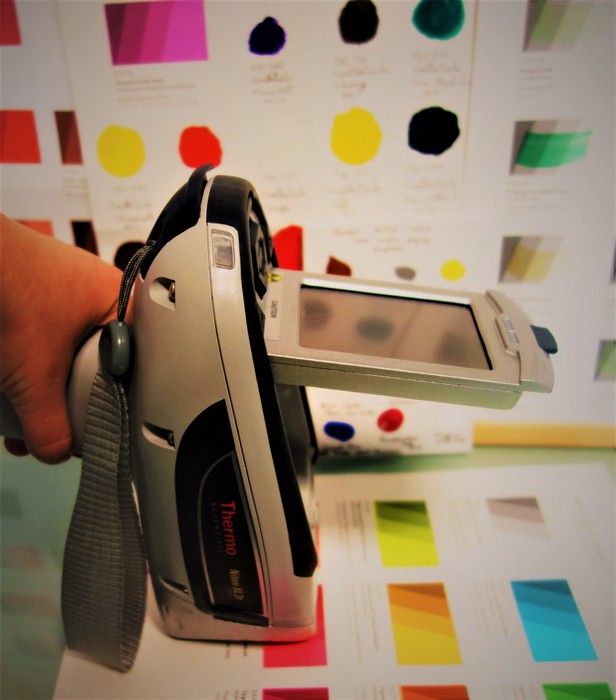OSE art comes on site for non-destructive analysis
OSE art now has a Niton™ XL3T GOLDD+ portable X-ray fluorescence analyser from ThermoScientific™ to offer its customers more comprehensive chemical analysis.
What is XRF?
X-ray fluorescence spectrometry is an elemental chemical analysis technique: it identifies the main elements present in a solid or powder sample. The technique is based on the principle of X-ray fluorescence: when a large quantity of X-rays emitted by an excitation source (X-ray tube) is directed onto the surface of a sample, it in turn emits its own X-rays, the energies of which are specific to each element on the surface. These rays are then collected by the detector and processed to produce an X-ray fluorescence spectrum.
OSE Art's analyser, the ThermoScientific™ Niton™ XL3t GOLDD+ allows reliable data acquisition in a very short time. It has multiple functions and is optimised with geometrically optimised wide area drift detector (GOLDD™) technology for improved analysis of light elements (Mg-S), very low detection thresholds and very fast measurement times.
OSE ART: On Site Expertise & Measurement
At OSE ART, we know that knowledge of the chemical composition of works of art makes it possible to understand the production techniques used by artists, or to identify forgeries and areas of retouching, but also to interpret certain degradation processes affecting cultural heritage.
In this context, the identification and chemical characterisation of pigments also play an important role, in order to answer technical and historical questions and to recover the original appearance of works of art.
XRF is a rapid, non-invasive (non-contact), non-destructive (no sampling required) analysis technique that can qualitatively identify several chemical elements.
We operate throughout France, Switzerland and Europe, subject to quotation.
Applications: painting, sculpture, furniture.....
Portable XRF can be used to analyse :
- Multicoloured surfaces such as frescoes, murals, easel paintings and paintings on wood
- Ceramics, sediments, terracotta, etc.
- Paper and parchment documents, inks
- Jewellery and metal objects
- Bronze
- Steel furniture
- Fillers, pigments....
- Legal expertise
OSE ART develops, researches and innovates
Example: Analysis of traces of titanium in paints containing barium
Titanium white (or titanium oxide) TiO2 is a white pigment widely used in paints. Titanium dioxide was officially named and first created in the laboratory towards the end of the 19th century. It was not produced in large quantities until the early 20th century. Its characterisation is hampered by the presence of barium.
However, this can be useful, particularly in the study of authenticity verification or doubts about an artistic fake.
The physico-chemical techniques for analysing pigments have evolved, which is why forgers in earlier times were not concerned about the presence of titanium in their preparations. The search for titanium white is therefore a typical research parameter in the field of counterfeiting.
It is therefore of interest to OSE ART to be able to identify and quantify titanium residues in paints for its expert appraisals, particularly for legal purposes. Nina Bensoussan, a student engineer at the Ecole de Chimie CPE Lyon, was asked by OSE ART to develop a method for detecting and quantifying titanium in paints where barium is also present. This method is specific to the ThermoScientific™ Niton™ XL3t GOLDD analyser.
A question, a quote? Get in touch with us!
